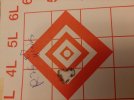.315 vs .318 between the Hornady and the Nosler indicates the brass on one is thicker than on the other ... if you want to use a bushing die, you would need to outside neck turn (or possibly inside ream) so that all the necks are equal thickness and therefore the bushing would then create identical internal diameter ... I don't care for this approach myself as I don't like to neck turn ... (NOTE: you should maintain consistency of brand/head stamp and if possible Lot# on brass when loading for accuracy or when approaching upper end of charge windows)
The collet die mentioned from Lee will squeeze the neck around a centered mandrel that is the "right size" for the caliber ... and it doesn't matter what the neck thickness and therefore outside diameter is (
so long as it safely chambers in the neck dimensions of YOUR rifle's chamber) ... if you want to vary the neck tension in the collet/mandrel setup, you just use a smaller or larger mandrel as opposed to a smaller or larger bushing ...
Lee Preicsion Collet Neck-sizing Dies

leeprecision.com
I've gone to the collet approach for nearly all my reloading -
even when I Full Length size (I remove the stem with expander) ... because there is no expander required when using a collet, the "pull" back across the expander (which creates a significant risk of adding runout) never happens and I end up with 0 +/- .001" runout consistently. My de-cap happens with the stem of the collet and still no expander.
Brass will last longer this way as the neck is worked far less (absolute minimum in fact) and run out is also minimum. Bushing dies can do this as well in all fairness but have other disadvantages (and also advantages) such as neck turning or the dreaded "donut" that can develop at the neck shoulder junction and you end up outside neck turning anyway ... or again ...
oh - and awesome group with that "junker" savage
@whirlwindjml ...

(I own and shoot almost nothing BUT savage 10/110 now for that very reason combined with the price)

